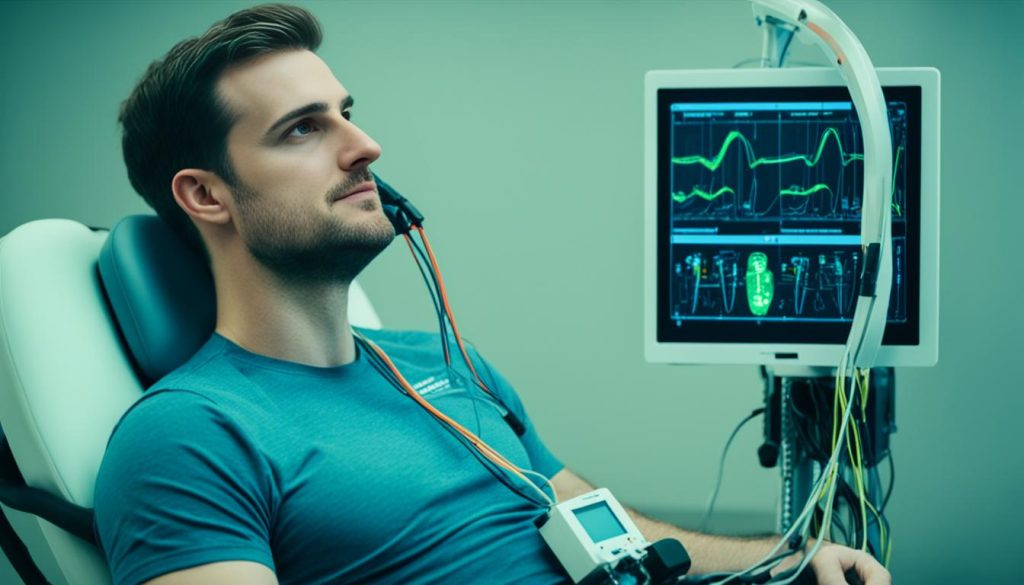Did you know that the polygraph test, commonly known as a lie detector test, is used by civil service and law enforcement agencies to screen candidates for integrity and trustworthiness? While the polygraph test is not 100% accurate, there are tips and techniques that can improve your chances of passing the examination. By understanding how the test works, preparing yourself mentally and physically, and debunking common myths, you can navigate the polygraph examination with confidence.
Key Takeaways:
- Proper preparation is essential to increase your chances of passing a polygraph test.
- The polygraph examination consists of three main sections: pre-test, actual test, and post-test.
- There are conflicting opinions on whether it’s possible to beat a polygraph test, but attempting to deceive the test can have serious consequences.
- The polygraph test is not infallible and can produce false results.
- Separate fact from fiction when it comes to the polygraph test and approach it with integrity and understanding of its limitations.
What is a Polygraph Test?
A polygraph test, also known as a psych test, truth verification test (TVT), lie detector test, or computer voice stress analysis (CVSA), is a process used to measure physiological responses during questioning to determine if a person is being truthful.
The test involves attaching various sensors to the candidate’s body, such as wires on the fingers to measure perspiration and temperature, straps around the chest to gauge breathing and heart rate, and a blood pressure cuff.
The test is intentionally designed to make the candidate feel uncomfortable and is based on the premise that physiological changes occur when a person is questioned under pressure. However, it’s important to note that the polygraph test is not 100% accurate and honest individuals can still fail.

| Polygraph Test Techniques | Pros | Cons |
|---|---|---|
| Psych Test | Can measure physiological responses | Not 100% accurate |
| Truth Verification Test (TVT) | Can assess honesty in questioning | Subject to false results |
| Lie Detector Test | Can detect physiological changes associated with deception | Relies on interpretation by examiner |
| Computer Voice Stress Analysis (CVSA) | Can analyze vocal characteristics for signs of stress | May lack scientific validation |
Tips for Passing a Polygraph Test
To increase your chances of passing a polygraph test, proper preparation is essential. Here are some tips to keep in mind:
- Understand the purpose of the test: Familiarize yourself with the purpose of the polygraph test and the types of questions that may be asked. This knowledge will help you stay calm and focused during the examination.
- Manage your anxiety: Anxiety can affect the accuracy of the test results. Practice relaxation techniques, such as deep breathing and visualization, to help calm your nerves before the test.
- Get a good night’s sleep: A well-rested mind and body are better equipped to handle stress. Make sure to get a full night’s sleep before the test to optimize your performance.
- Be honest: Honesty is crucial during the polygraph test. Attempting to deceive or manipulate the results can have serious consequences. Answer all questions truthfully and consistently.
- Follow instructions: Listen carefully to the instructions provided by the examiner. Pay attention to the order of questions, any physical adjustments required, and the required response format.
- Stay calm and relaxed: During the test, maintain a calm and relaxed demeanor. Avoid unnecessary movements or fidgeting, as it may interfere with the test results.
- Practice beforehand: If possible, practice answering potential polygraph test questions with a trusted friend or family member. This can help you become more comfortable with the testing process.
By following these tips and adequately preparing for the polygraph test, you can increase your chances of a successful outcome. Remember, the key is to approach the test with honesty, integrity, and a calm mindset.

| Myth | Fact |
|---|---|
| Myth: Polygraph tests are always accurate. | Fact: Polygraph tests can produce false results and are not 100% accurate. |
| Myth: Certain countermeasures guarantee success in deceiving the test. | Fact: Experienced examiners can detect countermeasures and deceptive techniques. |
Understanding the Polygraph Test Process
The polygraph examination consists of three main sections: the pre-test, the actual test, and the post-test.
During the pre-test phase, the examiner will explain the polygraph examination process and the purpose of the test. You will also be asked about your medical history and any factors that could affect the accuracy of the results. This information helps establish a baseline for your physiological responses, which will be compared to your reactions during the actual test.
The actual test is the core of the polygraph examination. It involves a series of relevant and control questions that are designed to elicit physiological responses. The relevant questions relate to the specific issue being investigated, while the control questions are meant to establish your baseline reactions. The examiner will monitor your heart rate, blood pressure, respiratory rate, and galvanic skin response throughout the test. Any significant changes in these physiological indicators may indicate deception.
After the actual test, the examiner may conduct a post-test phase. This phase aims to further analyze any inconsistencies in your responses and may involve additional questioning or clarification. It’s crucial to note that the entire time spent in the examination room is considered part of the test, so maintaining a consistent demeanor and honesty throughout is essential.
Beating a Polygraph Test: Fact or Fiction?
When it comes to the reliability of polygraph tests and the possibility of beating them, opinions are divided. Some sources claim that certain techniques, such as altering physiological responses or using countermeasures, can help deceive the test. However, reputable organizations like the National Research Council suggest that beating a polygraph test is not reliably achievable.
The accuracy of polygraph tests has been a subject of debate among scientific and legal communities. Despite claims of success, the test remains controversial due to its limitations. It’s important to approach the polygraph test with integrity and honesty, as attempting to manipulate the results can have serious consequences.
Image:
Myths and Facts about the Polygraph Test
When it comes to the polygraph test, there are several common myths that need to be dispelled. One such myth is that the polygraph is an infallible truth-telling device. In reality, the test is not 100% accurate and can produce false results. This means that even honest individuals may fail the test due to various factors, such as anxiety or physiological conditions.
Another myth surrounding the polygraph test is that certain countermeasures can guarantee success in deceiving the test. Some believe that biting their tongue or altering their breathing pattern can help them beat the test. However, experienced examiners are trained to detect these countermeasures and can still uncover deceptive behavior. It’s important to understand that attempting to manipulate the results can have serious consequences and is not advisable.
To approach the polygraph test with confidence, it’s crucial to separate fact from fiction. While the polygraph test can provide valuable insights, it is not foolproof and has limitations. Understanding these myths and facts surrounding the polygraph test can help candidates navigate the examination process with a realistic perspective and make informed decisions.